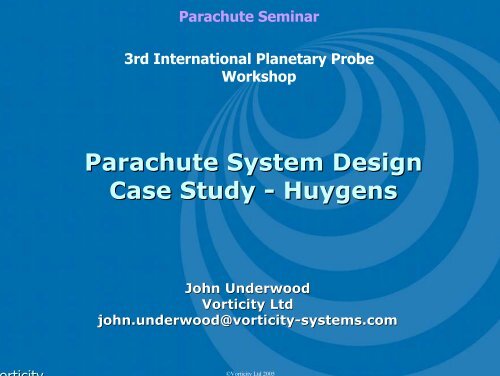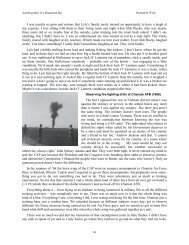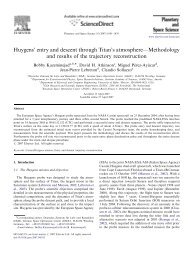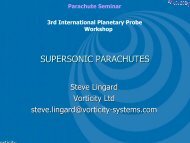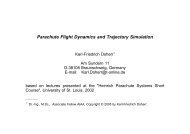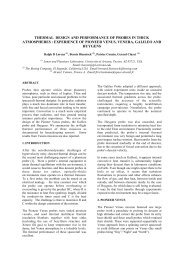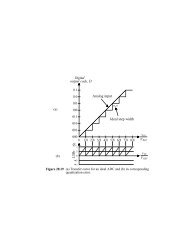Parachute System Design Case Study - Huygens
Parachute System Design Case Study - Huygens
Parachute System Design Case Study - Huygens
You also want an ePaper? Increase the reach of your titles
YUMPU automatically turns print PDFs into web optimized ePapers that Google loves.
<strong>Parachute</strong> Seminar<br />
3rd International Planetary Probe<br />
Workshop<br />
<strong>Parachute</strong> <strong>System</strong> <strong>Design</strong><br />
<strong>Case</strong> <strong>Study</strong> - <strong>Huygens</strong><br />
John Underwood<br />
Vorticity Ltd<br />
john.underwood@vorticity-systems.com<br />
john.underwood@vorticity systems.com<br />
©Vorticity Ltd 2005
<strong>Case</strong> <strong>Study</strong> - <strong>Huygens</strong><br />
Destination<br />
Titan<br />
Type<br />
Atmospheric Probe<br />
<strong>Parachute</strong> Requirements<br />
Remove protective aeroshell<br />
Stabilise transonic deceleration<br />
Control descent time<br />
No interference with probe spin<br />
©Vorticity Ltd 2005
Challenges<br />
Environment<br />
-210 210 to +25°C<br />
10 5 rads<br />
Cleanliness<br />
Reliability<br />
0.99 at 60% confidence level<br />
Testing<br />
Life<br />
Single Point Failures<br />
Conditions not similar to Earth<br />
7 Years in hard vacuum<br />
©Vorticity Ltd 2005
Operation Sequence (Option 1)<br />
Release rear aeroshell<br />
Includes annulus of front shield<br />
Deploys main parachute<br />
Release nose cap<br />
©Vorticity Ltd 2005
Operation Sequence (Option 2)<br />
Mortar-deploy Mortar deploy pilot chute<br />
Release back cover<br />
Removed by pilot chute<br />
Deploys main parachute(s)<br />
parachute(s<br />
Release front shield<br />
Reduce drag area to meet descent time<br />
Cut away all but one of a cluster of main<br />
parachutes<br />
Post-reef Post reef main parachute<br />
Use main parachute to deploy smaller parachute<br />
Release main parachute and free-fall free fall to surface<br />
©Vorticity Ltd 2005
Sequence Tradeoff<br />
Option 1<br />
Only one parachute<br />
Lack of heritage<br />
Complicated aeroshell<br />
release<br />
Release plane in front<br />
aeroshell<br />
©Vorticity Ltd 2005<br />
Option 2<br />
Two / three parachutes<br />
Galileo heritage<br />
Simple sequence<br />
Release plane is on rear<br />
of aeroshell<br />
BASELINE
Descent time modulation choice<br />
Cut away all but one of a cluster of main<br />
parachutes<br />
Complicated<br />
Post-reef Post reef main paracute<br />
Incompatible with swivel<br />
Use main parachute to deploy smaller<br />
parachute<br />
Baseline<br />
Release main parachute and free-fall free fall to<br />
surface<br />
Probe is unstable<br />
©Vorticity Ltd 2005
Sequence Choice<br />
When do we release the back cover?<br />
Supersonic sequence<br />
Release the back cover immediately pilot chute inflated<br />
Main parachute decelerates through Mach 1<br />
Subsonic sequence<br />
Retain back cover until Mach 0.6<br />
Pilot chute decelerates through Mach 1<br />
©Vorticity Ltd 2005
Subsonic vs Supersonic sequence<br />
Supersonic<br />
Main parachute better for<br />
transonic stabilisation<br />
Large bridle required for<br />
stability<br />
Baseline<br />
©Vorticity Ltd 2005<br />
Subsonic<br />
Main parachute loads<br />
lower<br />
Lighter<br />
Main parachute inflates<br />
subsonically<br />
Better inflation<br />
Potential for single BC/FS<br />
release
Final Sequence<br />
©Vorticity Ltd 2005
<strong>Parachute</strong> Materials<br />
Requirements<br />
Good cryogenic strength<br />
Compatibility with high temperature bake-out bake out<br />
Ability to join without significant strength loss<br />
Ability to weave (for broadloom fabrics)<br />
Availability<br />
At required yarn density<br />
Candidates<br />
Polyester, Nylon, Kevlar, Spectra, PTFE<br />
©Vorticity Ltd 2005
<strong>Parachute</strong> Materials<br />
Polyester<br />
Pioneer Venus, Viking, Galileo heritage<br />
Unable to weave lightweight fabric<br />
Kevlar<br />
Good strength properties<br />
Good for tapes / cords<br />
Poor for broadloom fabric<br />
Nylon<br />
Good temperature resistance<br />
High moisture gain<br />
Spectra<br />
High strength<br />
Poor high temperature performance<br />
Lack of heritage<br />
PTFE<br />
Poor strength<br />
©Vorticity Ltd 2005
Materials Choice<br />
Broadloom fabric<br />
Nylon<br />
Much improved since Polyester chosen for Pioneer<br />
Venus<br />
Water absorption required TML waiver<br />
Tapes and lines<br />
Kevlar<br />
Excellent strength and high temperature<br />
performance<br />
Threads<br />
Polyester / Kevlar<br />
©Vorticity Ltd 2005
Pilot Chute Type<br />
Requirements<br />
Inflation<br />
Supersonic<br />
Low dynamic pressure<br />
Stable<br />
Options<br />
Disk-Gap Disk Gap-Band Band<br />
Good supersonic, low dynamic pressure inflation<br />
Easy to build small scale models<br />
Variable Porosity Conical Ribbon<br />
Excellent supersonic inflation<br />
Very difficult to build scale models<br />
©Vorticity Ltd 2005
Pilot Chute Size<br />
Must separate back cover from probe<br />
Ballistic coefficient ratio better than 0.7<br />
Must use worst case<br />
Mass<br />
ββ<br />
=<br />
i<br />
∑<br />
Including all design margin<br />
Drag coefficient<br />
∑<br />
( C<br />
S<br />
)<br />
At worst Mach number<br />
j<br />
j<br />
m<br />
d<br />
ij<br />
ij<br />
©Vorticity Ltd 2005
Pilot Chute Size<br />
Released assembly<br />
Pilot chute<br />
Back cover<br />
MAIN PARACHUTE<br />
Masses<br />
Maximum mass<br />
Aerodynamics<br />
Minimum drag<br />
coefficients<br />
Include wake<br />
recirculation<br />
©Vorticity Ltd 2005<br />
Probe<br />
Remainder<br />
Masses<br />
Minimum mass<br />
Aerodynamics<br />
Maximum drag<br />
coefficient
ββ<br />
Pilot Chute Size (minimum)<br />
probe<br />
ββ<br />
m<br />
=<br />
C<br />
probe<br />
d<br />
BC<br />
max<br />
PC<br />
.<br />
min<br />
m<br />
=<br />
C<br />
+<br />
m<br />
S<br />
PC<br />
276<br />
.<br />
967<br />
min =<br />
=<br />
32<br />
.<br />
03<br />
d S d max S 1<br />
.<br />
510<br />
×<br />
5<br />
.<br />
726<br />
max<br />
PC<br />
max<br />
−<br />
C<br />
ββ =<br />
0<br />
.<br />
7<br />
ββ<br />
probe<br />
d<br />
released<br />
+<br />
m<br />
BC<br />
.<br />
max<br />
MP<br />
S<br />
max<br />
BC<br />
©Vorticity Ltd 2005<br />
probe<br />
kg<br />
m<br />
21<br />
.<br />
358<br />
+<br />
0<br />
.<br />
568<br />
+<br />
5<br />
.<br />
421<br />
=<br />
χχ<br />
0<br />
.<br />
38<br />
S<br />
−<br />
0<br />
.<br />
38<br />
×<br />
2<br />
.<br />
38<br />
×<br />
0<br />
.<br />
42<br />
S PC =<br />
PC = 4 .<br />
21<br />
m<br />
2<br />
PC<br />
N.B. All units are SI (kg, m, s)<br />
2
Pilot Chute <strong>Design</strong><br />
Size<br />
Type<br />
S0=5.29 m 2<br />
D0=2.59 m<br />
Lines: 12<br />
Line length: 2 x D 0<br />
Larger than minimum<br />
Disk-Gap Disk Gap-Band Band (13.1% geometric porosity)<br />
Taschengurts to stabilise band<br />
Materials<br />
Nylon broadloom fabric<br />
Kevlar lines and webbing<br />
©Vorticity Ltd 2005
Pilot Chute <strong>Design</strong> Loads<br />
Inflation load<br />
Maximum load was 1.8 kN<br />
Failure case – fire on arm<br />
Component design loads<br />
Component<br />
Canopy fabric<br />
Lines (12)<br />
Bridle legs (3)<br />
©Vorticity Ltd 2005<br />
Load<br />
0.89 N/m<br />
150 N<br />
1800 N
Pilot Chute <strong>Design</strong><br />
12 Gores<br />
Taschengurts<br />
12,2xD 0 Lines<br />
5.18 m<br />
21.1 m riser<br />
27 m trailing dist<br />
0.53 m bridle<br />
All Dimensions in metres<br />
©Vorticity Ltd 2005<br />
12 Gores<br />
So = 5.27 m2<br />
0.105<br />
0.072<br />
0.826<br />
0.250<br />
0.250<br />
0.134<br />
0.932<br />
0.308
Pilot Chute Testing<br />
Joint Tests<br />
Wind Tunnel Tests<br />
Environmental Tests<br />
Temperature<br />
Vibration<br />
Deployment Tests<br />
Bench<br />
Rapid<br />
Drop Tests<br />
<strong>System</strong> Test<br />
©Vorticity Ltd 2005
Mortar Type<br />
Requirements<br />
Deploy pilot chute through probe wake<br />
Minimum 24 m/s required<br />
Minimise reaction load<br />
Prevent contamination of payload<br />
Options<br />
Closed mortar<br />
Piston deploys parachute<br />
Gasses retained within mortar<br />
Open mortar<br />
Sabot deploys parachute<br />
Sabot released allowing gasses to exit<br />
©Vorticity Ltd 2005
Mortar Type<br />
Open<br />
Long stroke<br />
Low reaction loads<br />
Combustion products<br />
released<br />
May contaminate<br />
instruments<br />
Sabot and cap released<br />
BASELINE<br />
©Vorticity Ltd 2005<br />
Closed<br />
Short stroke<br />
High reaction loads<br />
Combustion products<br />
retained<br />
Could leak during<br />
science mission<br />
All components retained<br />
However, breakout<br />
patch in back cover<br />
released
Mortar <strong>Design</strong><br />
Open design<br />
Choked cartridge<br />
Twin NSI initiation<br />
Stowage for PC bridle<br />
Reaction load<br />
8.5 kN<br />
Velocity<br />
33 m/s<br />
Packing Density: 600 kg/m 3<br />
©Vorticity Ltd 2005
Mortar Testing<br />
Environmental Tests<br />
Temperature<br />
Vibration<br />
Functional Tests<br />
Ambient<br />
Temperature Conditioned<br />
<strong>System</strong> Test<br />
©Vorticity Ltd 2005
Main <strong>Parachute</strong> Type<br />
Requirements<br />
Good supersonic inflation<br />
Good low dynamic pressure inflation<br />
Good stability<br />
Options<br />
Disk-Gap Disk Gap-Band Band<br />
Variable Porosity Conical Ribbon<br />
Ringsail<br />
Ringslot<br />
Cruciform<br />
©Vorticity Ltd 2005
Main <strong>Parachute</strong> Type<br />
Disk-Gap Disk Gap-Band Band<br />
Proven design<br />
Comonality with pilot Chute<br />
VPCR<br />
Difficult to test at small scale<br />
Ringsail, Ringslot, Ringslot,<br />
Cruciform<br />
Unproven or poor supersonic performance<br />
DGB chosen<br />
©Vorticity Ltd 2005
Main <strong>Parachute</strong> Size<br />
Requirements<br />
Transonic Stability<br />
Simulations<br />
Separation of probe from front aeroshell<br />
ββ<br />
ββ<br />
FS<br />
Ballistic coefficient ratio better than 0.7<br />
probe<br />
m<br />
=<br />
C<br />
d<br />
FS<br />
FS<br />
.<br />
max<br />
=<br />
0<br />
.<br />
7<br />
ββ<br />
71<br />
.<br />
491<br />
min =<br />
=<br />
12<br />
.<br />
71<br />
kg<br />
m<br />
S<br />
0<br />
.<br />
982<br />
×<br />
5<br />
.<br />
726<br />
FS<br />
FS<br />
m<br />
=<br />
C<br />
MP<br />
Reference area at least 47.3 m 2<br />
d<br />
probe<br />
MP<br />
.<br />
min<br />
max<br />
S<br />
©Vorticity Ltd 2005<br />
205<br />
.<br />
863<br />
=<br />
0<br />
.<br />
489<br />
×<br />
S<br />
MP<br />
2
Main <strong>Parachute</strong> <strong>Design</strong><br />
Disk-Gap Disk Gap-Band Band<br />
D0=8.3 =8.3 m<br />
S0=54.1 =54.1 m 2<br />
Geometric porosity: 22.4%<br />
Lines: 24<br />
Materials<br />
Nylon broadloom fabric<br />
Kevlar lines and webbing<br />
©Vorticity Ltd 2005
Main <strong>Parachute</strong> <strong>Design</strong> Load<br />
Inflation load<br />
Maximum load was 14.7 kN<br />
Failure case – fire on arm<br />
Component design loads<br />
Component<br />
Canopy fabric<br />
Lines (12)<br />
Bridle legs (3)<br />
©Vorticity Ltd 2005<br />
Load<br />
2.27 N/m<br />
613 N<br />
14700 N
Main <strong>Parachute</strong> <strong>Design</strong><br />
24 Gores<br />
24,2xD 0 Lines<br />
16.6 m<br />
6.0 m riser<br />
27 m trailing dist<br />
3.9 m bridle<br />
Optimised for stability<br />
Swivel<br />
©Vorticity Ltd 2005<br />
0.375<br />
0.411<br />
2.846<br />
0.643<br />
0.939<br />
0.375
Main <strong>Parachute</strong> Testing<br />
Joint Tests<br />
Wind Tunnel Tests<br />
Environmental Tests<br />
Temperature<br />
Vibration<br />
Deployment Tests<br />
Bench<br />
Rapid<br />
Drop Tests<br />
<strong>System</strong> Test<br />
©Vorticity Ltd 2005
Swivel Requirements<br />
Requirements<br />
Decouple probe rotation from parachute<br />
Maximum allowable torque<br />
0.01 Nm (F245N)<br />
Withstand Main <strong>Parachute</strong> opening load<br />
14.7 kN<br />
Environment<br />
Cryogenic<br />
Compatibility with outgassing<br />
©Vorticity Ltd 2005
Swivel <strong>Design</strong><br />
Thrust Ball Bearings<br />
Redundant main bearings<br />
Compliant preload<br />
Redundant preload bearings<br />
Tribology<br />
MoS 2 coating on races<br />
TiC & MoS 2 coating on balls<br />
©Vorticity Ltd 2005
<strong>Parachute</strong> Release Mechanism<br />
Requirements<br />
Withstand main parachute opening load<br />
Release all three parachute attachments<br />
simultaneously<br />
Low or zero force required for separation<br />
High reliability<br />
Environment<br />
Cryogenic temperatures<br />
©Vorticity Ltd 2005
PRM Trades<br />
Location<br />
At bridle confluence<br />
Single Unit<br />
Bridle remains attached to probe<br />
Three locations on upper platform<br />
Ease of integration<br />
Three locations beneath upper platform<br />
Benign environment<br />
©Vorticity Ltd 2005
PRM Trades<br />
Mechanism<br />
Release nut below platform<br />
Galileo, Pioneer Venus<br />
Not fully redundant<br />
Gas locks with dual cartridges and gas distribution<br />
Used on ejection seats<br />
Good simultaneity<br />
Single gas source<br />
Heavy<br />
Pyrotechnic rod cutters<br />
Commonality with SEPS<br />
©Vorticity Ltd 2005
PRM <strong>Design</strong><br />
Three mechanisms<br />
One for each bridle leg<br />
Fully redundant rod cutters<br />
Twin ESI initiation<br />
No sharp corners<br />
©Vorticity Ltd 2005
Stabilising Drogue Type<br />
Requirements<br />
Good low dynamic pressure inflation<br />
10 Pa<br />
Good stability during descent<br />
Set overall descent time<br />
Options<br />
Cruciform<br />
Guide surface<br />
Disk-Gap Disk Gap-Band Band<br />
©Vorticity Ltd 2005
Stabilising Drogue Type<br />
Cruciform<br />
Excellent stability from literature<br />
Poor stability in wind tunnel models<br />
Guide surface<br />
Good stability<br />
Unproven low dynamic pressure inflation<br />
Disk-Gap Disk Gap-Band Band<br />
Commonality with other parachutes<br />
Excellent stability in wind tunnel tests<br />
©Vorticity Ltd 2005
Stabilising Drogue Size<br />
Size determined by system descent time<br />
3 dof trajectory code used to determine size<br />
Nominal descent time: 2.25 hours<br />
©Vorticity Ltd 2005
Stabilising Drogue <strong>Design</strong><br />
Disk-Gap Disk Gap-Band Band<br />
D0=3.03 =3.03 m<br />
S0=7.23 =7.23 m 2<br />
Geometric porosity: 22.4%<br />
Lines: 24<br />
Materials<br />
Nylon broadloom fabric<br />
Kevlar lines and webbing<br />
©Vorticity Ltd 2005
Stabilising Drogue <strong>Design</strong> Load<br />
Canopy and upper strop<br />
Steady-state Steady state descent: 300 N<br />
Lower strop and bridle<br />
Deployment snatch load: 1.8 kN<br />
Due to rapid deployment<br />
Component<br />
Canopy fabric<br />
Lines (24)<br />
Bridle legs (3)<br />
Load<br />
13 N<br />
©Vorticity Ltd 2005<br />
0.13 N/m<br />
1800 N
Stabilising Drogue <strong>Design</strong><br />
24 Gores<br />
24,2xD 0 Lines<br />
6.06 m<br />
1.0 m riser<br />
12 m trailing dist<br />
3.9 m bridle<br />
Optimised for stability<br />
Swivel<br />
©Vorticity Ltd 2005<br />
0.235<br />
0.150<br />
1.041<br />
0.343
Container<br />
Requirements<br />
Storage<br />
Main <strong>Parachute</strong><br />
Stabilising Drogue<br />
Thermal protection<br />
Restrain parachutes<br />
<strong>Design</strong><br />
CG position must not change<br />
Must not resonate<br />
Aluminium structure<br />
Packing Density: 300 kg/m 3<br />
©Vorticity Ltd 2005
Integration<br />
Attached to upper platform<br />
<strong>Parachute</strong> bridles<br />
Avoid fragile items<br />
Antennae<br />
Velcro attachment<br />
Exposed fabric<br />
Kevlar only<br />
High temperatures<br />
©Vorticity Ltd 2005
Reliability<br />
Single Point Failures<br />
Unavoidable in parachute systems<br />
PDD Cartridge<br />
PDD Body<br />
Pilot Chute<br />
Extraction lanyards (2)<br />
Container<br />
Main <strong>Parachute</strong><br />
Swivels<br />
PJM (3)<br />
Stabilising Drogue<br />
©Vorticity Ltd 2005
Mass Breakdown<br />
EQUIPMENT Min Mass Nom Mass Max Mass<br />
(kg) (kg) (kg)<br />
Pilot Chute 0.638 0.645 0.651<br />
Main <strong>Parachute</strong> 4.527 4.573 4.751<br />
SDA 0.751 0.758 0.787<br />
Swivel Assemblies 0.814 0.823 0.831<br />
PDD Assembly 1.257 1.269 1.282<br />
PJM Assembly 2.123 2.145 2.166<br />
Container Assembly 1.685 1.702 1.719<br />
BoP Assembly 0.213 0.218 0.222<br />
TOTAL 12.008 12.132 12.408<br />
©Vorticity Ltd 2005
Conclusion<br />
7 year development<br />
7 year delivery<br />
2.5 hour mission<br />
24 Papers at this conference<br />
6 Posters<br />
©Vorticity Ltd 2005


